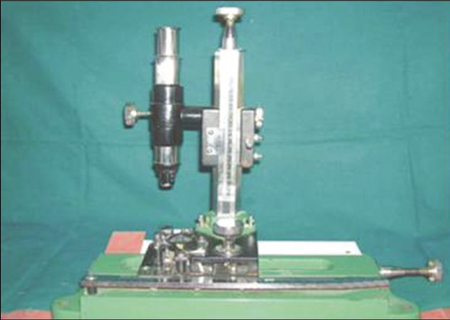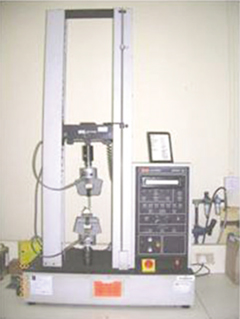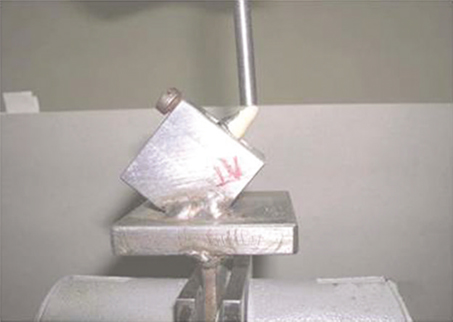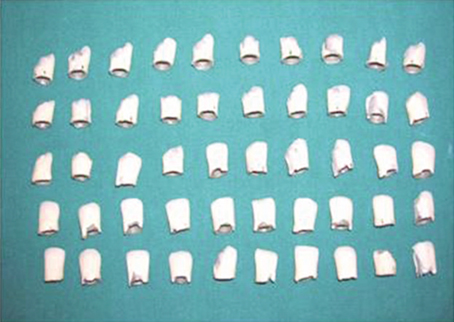J Adv Prosthodont.
2011 Sep;3(3):113-118. 10.4047/jap.2011.3.3.113.
Alternate metal framework designs for the metal ceramic prosthesis to enhance the esthetics
- Affiliations
-
- 1Department of Prosthodontics, Government Dental College and Research Institute, Bellary, Karnataka, India. manjunathark@yahoo.co.in
- 2Department of Medical Statistics, Government Dental College and Research Institute, Bellary, Karnataka, India.
- KMID: 2118118
- DOI: http://doi.org/10.4047/jap.2011.3.3.113
Abstract
- PURPOSE
The objective of the present study was to evaluate the effect of five different metal framework designs on the fracture resistance of the metal-ceramic restorations.
MATERIALS AND METHODS
For the purpose of this study, the central incisor tooth was prepared, and the metal analogue of it and a master die were fabricated. The counter die with the 0.5 mm clearance was used for fabricating the wax patterns for the metal copings. The metal copings with five different metal framework designs were designed from Group 1 to 5. Group 1 with the metal collar, Group 2, 3, 4 and 5 with 0 mm, 0.5 mm, 1 mm and 1.5 mm cervical metal reduction respectively were fabricated. Total of fifty metal ceramic crown samples were fabricated. The fracture resistance was evaluated with the Universal Testing Machine (Instron model No 1011, UK). The basic data was subjected to statistical analysis by ANOVA and Student's t-test.
RESULTS
Results revealed that the fracture resistance ranged from 651.2 to 993.6 N/m2. Group 1 showed the maximum and Group 5 showed the least value.
CONCLUSION
The maximum load required to fracture the test specimens even in the groups without the metal collar was found to be exceeding the occlusal forces. Therefore, the metal frameworks with 0.5 mm and 1 mm short of the finish line are recommended for anterior metal ceramic restoration having adequate fracture resistance.
MeSH Terms
Figure
Reference
-
1. Rosenstiel SF, Land MF, Fujimoto J. Contemporary fixed prosthodontics. 2001. 3rd ed. St Louis: Mosby; Elsevier publishers.2. Anusavice KJ. Philip's science of dental materials. 2003. 11th ed. Saunders; Elsevier publishers.3. Brecker SC. Porcelain baked to gold a new medium in prosthodontics. J Prosthet Dent. 1956. 6:801–810.4. Goodacre CJ, Van Roekel NB, Dykema RW, Ullmann RB. The collarless metal-ceramic crown. J Prosthet Dent. 1977. 38:615–622.5. Warpeha WS Jr, Goodkind RJ. Design and technique variables affecting fracture resistance of metal-ceramic restorations. J Prosthet Dent. 1976. 35:291–298.6. O'Boyle KH, Norling BK, Cagna DR, Phoenix RD. An investigation of new metal framework design for metal ceramic restorations. J Prosthet Dent. 1997. 78:295–301.7. Prince J, Donovan T. The esthetic metal-ceramic margin: a comparison of techniques. J Prosthet Dent. 1983. 50:185–192.8. Sozio RB, Riley DJ. A precision ceramic-metal restoration with a facial butted margin. J Prosthet Dent. 1977. 37:517–521.9. Toogood GD, Archibald JF. Technique for establishing porcelain margins. J Prosthet Dent. 1978. 40:464–466.10. Vryonis P. A simplified approach to the complete porcelain margin. J Prosthet Dent. 1979. 42:592–593.11. Hamaguchi H, Cacciatore A, Tueller VM. Marginal distortion of the porcelain- bonded-to-metal complete crown: an SEM study. J Prosthet Dent. 1982. 47:146–153.12. Prince J, Donovan TE, Presswood RG. The all-porcelain labial margin for ceramometal restorations: a new concept. J Prosthet Dent. 1983. 50:793–796.13. Oram DA, Davies EH, Cruickshanks-Boyd DW. Fracture of ceramic and metalloceramic cylinders. J Prosthet Dent. 1984. 52:221–230.14. Anusavice KJ, Hojjatie B. Stress distribution in metal-ceramic crowns with a facial porcelain margin. J Dent Res. 1987. 66:1493–1498.15. Richter-Snapp K, Aquilino SA, Svare CW, Turner KA. Change in marginal fit as related to margin design, alloy type, and porcelain proximity in porcelain-fused-to-metal restorations. J Prosthet Dent. 1988. 60:435–439.16. Hinrichs RE, Bowles WF 3rd, Huget EF. Apparent density and tensile strength of materials for facially butted porcelain margins. J Prosthet Dent. 1990. 63:403–407.17. Belles DM, Cronin RJ Jr, Duke ES. Effect of metal design and technique on the marginal characteristics of the collarless metal ceramic restoration. J Prosthet Dent. 1991. 65:611–619.18. Campbell SD, Pelletier LB. Thermal cycling distortion of metal ceramics: Part I-Metal collar width. J Prosthet Dent. 1992. 67:603–608.19. Lund PS, Barber BA. The effect of porcelain veneer extension on strength of metal ceramic crowns. Int J Prosthodont. 1992. 5:237–243.20. Boyle JJ Jr, Naylor WP, Blackman RB. Marginal accuracy of metal ceramic restorations with porcelain facial margins. J Prosthet Dent. 1993. 69:19–27.21. Smith TB, Kelly JR, Tesk JA. In vitro fracture behavior of ceramic and metal-ceramic restorations. J Prosthodont. 1994. 3:138–144.22. Lehner CR, Männchen R, Schärer P. Variable reduced metal support for collarless metal ceramic crowns: a new model for strength evaluation. Int J Prosthodont. 1995. 8:337–345.23. Gardner FM, Tillman-McCombs KW, Gaston ML, Runyan DA. In vitro failure load of metal-collar margins compared with porcelain facial margins of metal-ceramic crowns. J Prosthet Dent. 1997. 78:1–4.24. Ku CW, Park SW, Yang HS. Comparison of the fracture strengths of metal-ceramic crowns and three ceromer crowns. J Prosthet Dent. 2002. 88:170–175.25. Ulusoy M, Toksavul S. Fracture resistance of five different metal framework designs for metal-ceramic restorations. Int J Prosthodont. 2002. 15:571–574.26. Gibbs CH, Mahan PE, Lundeen HC, Brehnan K, Walsh EK, Holbrook WB. Occlusal forces during chewing and swallowing as measured by sound transmission. J Prosthet Dent. 1981. 46:443–449.27. Silver M, Klein G, Howard MC. An evaluation and comparison of porcelain-fused-to-cast metals. J Prosthet Dent. 1960. 10:1055–1064.28. Nielsen JP, Tuccillo JJ. Calculation of interfacial stress in dental porcelain bonded to gold alloy substrate. J Dent Res. 1972. 51:1043–1047.29. Hinrichs RE, Bowles WF 3rd, Huget EF. Apparent density and tensile strength of materials for facially butted porcelain margins. J Prosthet Dent. 1990. 63:403–407.30. Waltimo A, Könönen M. A novel bite force recorder and maximal isometric bite force values for healthy young adults. Scand J Dent Res. 1993. 101:171–175.
- Full Text Links
- Actions
-
Cited
- CITED
-
- Close
- Share
- Similar articles
-
- Fabrication of a metal-ceramic crown to fit an existing partial removable dental prosthesis using ceramic pressed to metal technique: a clinical report
- A study on frictional resistance force of orthodontic resin bracket
- Retreatment of implant-supported hybrid prosthesis with existing metal framework: a case report
- A comparative study on the bond strength of porcelain to the millingable Pd-Ag alloy
- Frictional resistance of different ceramic brackets and their relationship to the second order angulation between bracket slot and wire







